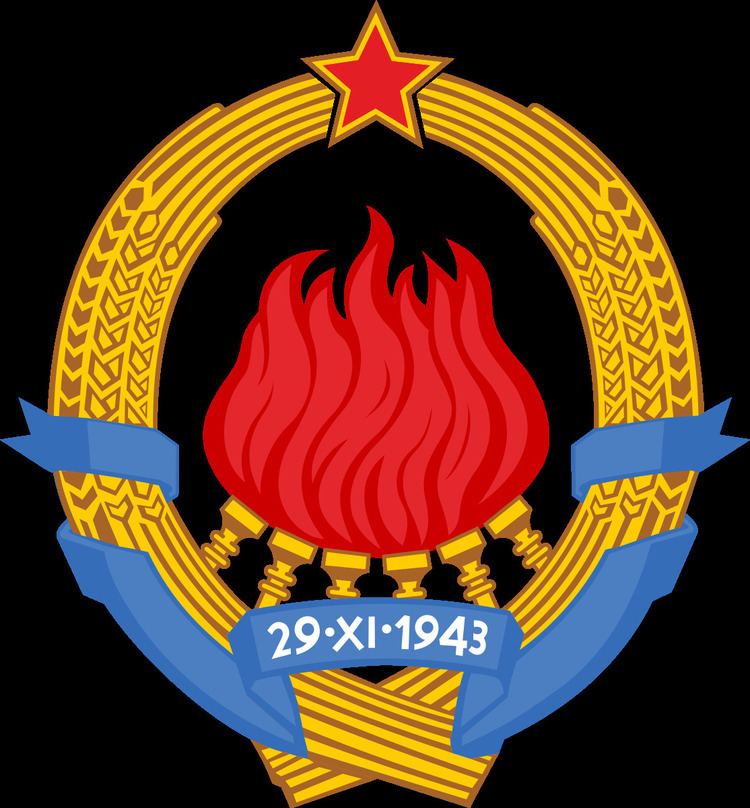Adopted 1963 | ||
 | ||
Use As official emblem of Yugoslavia | ||
The emblem of Yugoslavia featured six torches, surrounded by wheat with a red star at its top, and burning together in one flame; this represented the brotherhood and unity of the six federal republics forming Yugoslavia: Serbia, Croatia, Bosnia and Herzegovina, Slovenia, Montenegro, and Macedonia. The date imprinted is 29 November 1943 - on this date the Anti-Fascist Council of National Liberation of Yugoslavia (AVNOJ) met in Jajce on its second meeting and formed the basis for post-war organisation of the country, establishing a federal republic (this date was celebrated as Republic Day after World War II). The emblem of Yugoslavia, along with those of its constituent republics, are an example of socialist heraldry.
Contents
Kingdom of Yugoslavia
The coat of arms of the Kingdom of Yugoslavia (previously called Kingdom of Serbs, Croats and Slovenes) was an evolution of the Coat of arms of Serbia. Graphically the coat of arms were similar, featuring only two major differences, the first difference being the royal crowns. The royal Serbian coat of arms depicts the Obrenović dynastic crown, while the royal Yugoslav coat of arms depicted the ruling Karađorđević dynastic crown.
The second difference was the shield surmounted on the white double-headed eagle. The previous Serbian coat of arms depicted only the Serbian tetragrammatic cross, representing only the Serbian nation. When Yugoslavia was formed, the surmounted shield was altered to include the newly integrated Croat and Slovene nations, as the three official nations of Yugoslavia. The coat of arms includes three golden six-armed stars in the form of an upside down triangle, adopted from the coat-of-arms of the Counts of Celje family. An image of the royal Yugoslav coat of arms can be seen on the 10-Yugoslav dinar banknote of 1926.
SFR Yugoslavia
During World War II (1943–1945), the Yugoslav state was named Democratic Federal Yugoslavia (DFY), in 1945 it was renamed Federal People's Republic of Yugoslavia (FPR Yugoslavia), and again in 1963 into Socialist Federal Republic of Yugoslavia (SFR Yugoslavia). The emblem of socialist Yugoslavia was designed in 1943 and remained in use up to 1963, when the country underwent reforms and was renamed for the final time. It featured five torches surrounded by wheat and burning together in one flame; this represented the brotherhood and unity of the five nations of SFR Yugoslavia: Croats, Serbs, Montenegrins, Macedonians, and Slovenes. The Bosniaks were not represented as a constituent nation, despite having an independent republic prior to the formation of the Kingdom of Yugoslavia.
As part of the 1963 reforms, the name of the country was changed into Socialist Federal Republic of Yugoslavia and its emblem was redesigned to represent six Yugoslav federal republics (instead of the five nations). The new emblem was the final version with six torches, and was in official use up to the country's dissolution in 1992. The date of the insignia remained the same, 29 November 1943, the date the Anti-Fascist Council of National Liberation of Yugoslavia (AVNOJ) met in Jajce on its second meeting.
Republic emblems
The emblems of the Yugoslav socialist republics were defined by each of its six constituent republics. Emblems appeared as a symbol of statehood on the documents of republican level, for example on the signs of the republican institutions, on watermarks of school diplomas, etc. The emblems included old historical symbols where they could demonstrate historical compatibility with the new socialist political system – see Croatian and Serbian traditional emblem in the middle of their coats of arms; also Slovenian Mount Triglav was recognized as a symbol of Slovenian Liberation Front during the National Liberation War during World War II. Where the old symbols were deemed inappropriate (the traditional cross on the Serbian coat of arms, ethnic or religious coat of arms for Bosnia and Herzegovina, the former traditionally monarchist symbol for Montenegro or the historical lion for Macedonia), prominent features or unofficial national symbols were added, e.g. Mount Lovćen for Montenegro, or a pair of chimneys for Bosnia and Herzegovina.
The same with the federal Yugoslav emblem: all separate republican emblems featured a red star, and wheat or other important plants from that region. The individual emblems of the six Yugoslav socialist republics were as follows:
